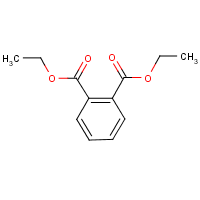Diethyl phthalate
Agent Name
Diethyl phthalate
CAS Number
84-66-2
Formula
C12-H14-O4
Major Category
Plastics & Rubber

Synonyms
1,2-Benzenedicarboxylic acid, diethyl ester; Anozol; DEP; DPX-F5384; Di-n-ethyl phthalate; Diethyl 1,2-benzenedicarboxylate; Diethyl o-phenylenediacetate; Diethyl o-phthalate; Diethyl phthalate; Diethylester kyseliny ftalove [Czech]; Estol 1550; Ethyl phthalate; Neantine; Palatinol A; Phthalol; Phthalsaeurediaethylester [German]; Placidol E; Solvanol; Unimoll DA; o-Benzenedicarboxylic acid diethyl ester; o-Bis(ethoxycarbonyl)benzene; [ChemIDplus] UN8027
Category
Phthalate Esters
Description
Colorless to water-white, oily liquid with a very slight, aromatic odor. (pesticide); [NIOSH]
Sources/Uses
Plasticizer (added to polymers to effect flexibility and/or toughness); also used as an insect repellant and solvent; [ACGIH] Used as a solvent in cellulose acetate, fragrances, and cosmetics; [Merck Index #7371]
Comments
The heated compound is an irritant to the eyes and respiratory tract; [ACGIH] Allergic contact dermatitis reported; [Kanerva, p. 1782] In high-dose reproductive studies of rats and mice, DEHP and other phthalates cause testicular damage to males and increased fetal losses and malformations to pregnant females. [Frazier, p. 350-2] Low toxicity both acute and chronic, but could cause CNS depression if large dose absorbed; [HSDB]
Reference Link #1
Biomedical References
Exposure Assessment
Skin Designation (ACGIH)
Insufficient data
TLV (ACGIH)
5 mg/m3
Vapor Pressure
0.002 mm Hg
Explanatory Notes
Flash point = 161 deg C;
Reference Link #2
NFPA
must be preheated
Adverse Effects
Skin Sensitizer
Yes
Reproductive Toxin
Yes
ACGIH Carcinogen
Not Classifiable
Diseases, Processes, and Activities Linked to This Agent
Diseases
Occupational diseases associated with exposure to this agent:
Processes
Industrial Processes with risk of exposure: